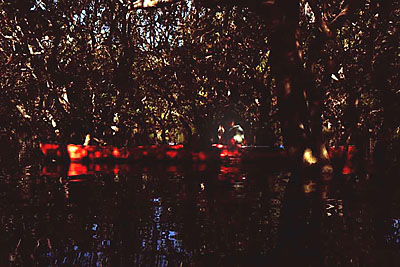 Back in 2001, on my first trip to New Zealand, I had a chance to go kayaking amongst the mangroves in the Bay of Islands. Recently, I found my notes on mangroves, particularly upon how they handle salt water – I’m always intrigued by life pushing the margins.
Back in 2001, on my first trip to New Zealand, I had a chance to go kayaking amongst the mangroves in the Bay of Islands. Recently, I found my notes on mangroves, particularly upon how they handle salt water – I’m always intrigued by life pushing the margins.
The New Zealand mangroves, according to my guidebook, are among the southernmost examples of these trees in the world. Avicennia marina var resinifera – but the resinifera is a misnomer arising from the finding by Joseph Banks, Captain Cook’s scientific observer, of resin among the roots, resin that comes from kauri trees. To the Maori they are manawa. In NZ they’re near their southern limit, a single species out of 55 worldwide (54 in Hogarth, 1999). Around Auckland they’re stunted and impenetrable, but in the bay of Islands they grow up to 15 m. According to Deanna (the guide), they filter seawater through their roots, but seawater is too salty for them, so they concentrate the salt in certain of their leaves. The salt is either washed away by a heavy rainfall or the leaves die and drop off. Mangroves shed constantly. They obtain oxygen through their leaves and through air-roots, which jut up from the mud and are submerged at high tide, so are sealed. The roots are wide and shallow extending horizontally to up to five times the tree’s upper radius, since the aerobic layer in the mud is very thin. Mangroves have no rings, and presumably do not have seasonally dictated cycles. Mangrove seeds, which float, already contain a seedling consisting of two leaves, a stem and a root, so if they fall during low tide and strike solid ground, the seedling can root before the next tide. If not, if the seed/pod falls into water, it can float for months until it comes to rest. Among the roots are mangrove seedlings, planted, which can wait in a state of arrested growth for years until one of the trees around it dies. Mangrove growth is self regulating. Nothing nests in the NZ mangroves, though they do in other mangrove species; however 36 species of fish use the mangroves as a nursery. As the tide receded we could hear the sharp little clicks of exposed shrimp.
Worldwide there are 55 species (54 in Hogarth) of mangroves, of which NZ has one (not exclusive to NZ). They are facultative halophytes, that is they can survive in freshwater but prefer diluted saltwater; in freshwater they are likely to be out-competed. They’re almost exclusively tropical, being frost-intolerant with vulnerable (vivaporous) seedlings, they rarely occur north of the winter position of the 20 C winter isotherm and the number of species decreases as the they approach their northern limit. They grow further south on the eastern margins of landmasses than the western, which reflects ocean circulation and the pattern of warm and cold currents. The highest-latitude species found is a species of Avicennia, in Australia.
Typical mangrove habitats are have periodic tidal inundation, waterlogged soil and fluctuating salinity. The diffusion rate of water is 10 000-fold less than through air, and oxygen movement into the mud is severely limited; mangrove soils are virtually anoxic. Ferric ion is converted to ferrous ion, with release of iron and inorganic phosphates, sulphate to sulphide, carbon dioxide to methane, and there is bacterial conversion of nitrate to nitrogen. Since they live in anaerobic mud, they take in oxygen through arial roots or pneumatrophores. Black mangroves and white mangroves (including Avicennia), have pneumatophores, red mangroves have prop roots.
There are two principal adverse effects of salt in plants – osmotic stress and the toxicity of Na+ and or Cl-. Glycophytes are salt-intolerant, whereas halophytes grow fine, and sometimes better, in
salt; there is a continuum from extreme glycophytes to extreme halophytes. Salt avoidance strategies minimize the salt concentration in cells. Salt tolerance includes physiologic mechanisms and adaptations for maintaining viability with accumulation. Plants can protect themselves by salt exclusion or by ridding themselves of the salt. Exudatives have glandular cells capable of excreting excess salt. Succulants grow where there is no restriction on water – they use increase in water content within large vacuoles to minimize salt toxicity. Obligatory halophytes require salt; facultative halophytes can live in fresh water.
Various mechanisms are involved in mangroves’ salt tolerance:
- Salt exclusion – ultrafilters in the plant roots reduce uptake of salt. This is less efficient than salt excretion: red mangroves, which rely on salt exclusion, require salinities < 60-65 ppt. Black and white mangroves, which use salt excretion, can tolerate salinities up to 80-90 ppt.
- Salt excretion – salt is excreted through specialized salt glands in leaves. This is an active process, involving ATPase activity in plasmalemma
- Water conservation under conditions of high stress.
- Mangroves may also accumulate or synthesize other solutes to regulate and maintain osmotic balance – eg mannitol, proline, glycine betaine, aspartate, stachyose. They also deliberately slow their water intake to prevent excluded salt from accumulating around their roots.
- Low transportation and slow water uptakes is not characteristic of all mangroves.
There is a great deal of interest in salt resistant plants as a means of extending arable ground, water supplies and reclaiming land ruined by over-irrigation — this is well-represented on the web.